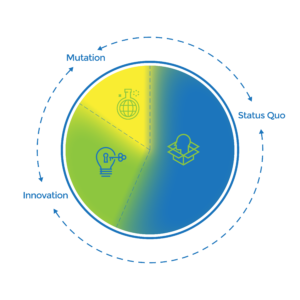 Being truly innovative requires the capacity to be in a constant state of change, recognizing the impact of difference iterations in the movements from “status quo –> innovation –> mutation” and back again.
Being truly innovative requires the capacity to be in a constant state of change, recognizing the impact of difference iterations in the movements from “status quo –> innovation –> mutation” and back again.
Another way to characterize Ecosystems is by their intent – their “State.” Some organizations work hard to stay the same; to maintain the Status Quo. Other teams and organizations have as their goal to change the status quo; pursuing Innovation – making evolutionary changes to better cope with internal or external needs for change. Yet other organizations challenge themselves to create revolutionary change – inventing something new; a brandnew paradigm, a new suite of products, services, or technology. We’ve named this third set of objectives Mutation.
Each of these States can be differentiated according to two properties:
- Amount or intensity of change
- Amount of time required to introduce change
We have consistently used the concept of “states” — for understanding and identifying an organization’s current and desired future states. Clearly identifying our three “states” — status quo, innovation and mutation — establishes a baseline view of expereince, expectations, engagements and actions throughout the ecosystem.
 The “status quo”state is a system’s “business as usual” space, where everyone involved knows what to do, what results to expect, and what behaviors will support these patterns.
The “status quo”state is a system’s “business as usual” space, where everyone involved knows what to do, what results to expect, and what behaviors will support these patterns.
In the “innovation” state, the organization seeks to “do what it already does better.” It engages in a continuum of controlled experimentation, engagement and self-organization. This is the space of continuous improvement and evolutionary change.
The “mutation” state of the landscape is where little agreement and certainty exists about what or how things are happening. We like to explain this state as one of “mutational opportunity.” It is in this space that diverse and varied information, networks, and engagements can provide significant value by “driving” intuition toward understanding.
Want to know more?
